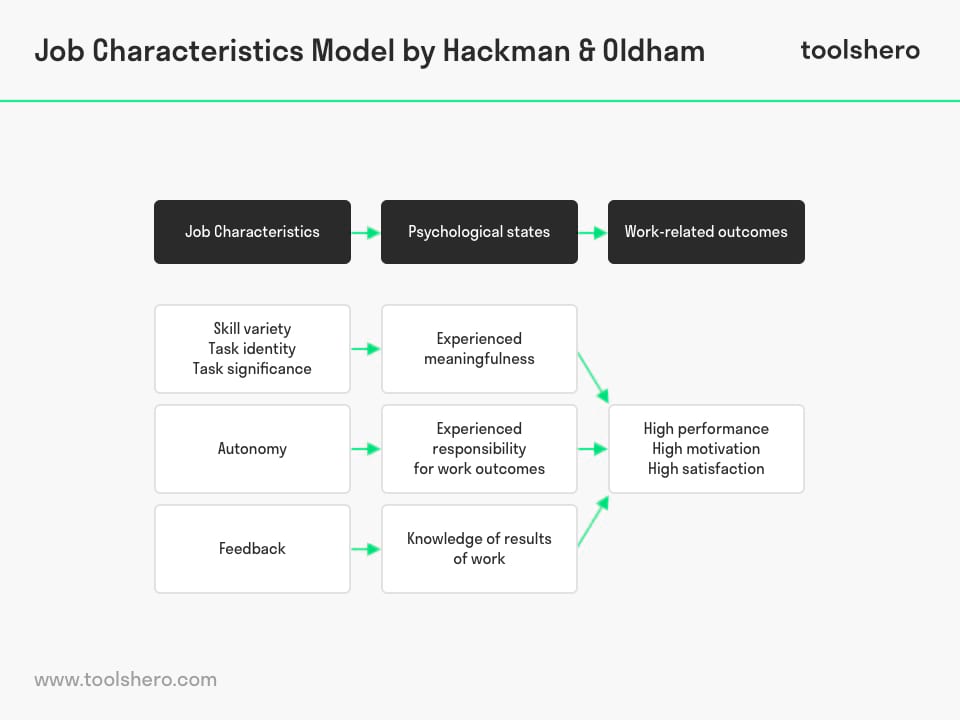Job Characteristics Model (Hackman and Oldham)

Job Characteristics Model: this article provides a practical explanation of the Job Characteristics Model (JCM), developed by Richard Hackman and Greg Oldham. Next to what it is, this article also highlights the design, the indexing scores, the work-related results and the moderators. After reading, you’ll understand the basics of this human resource management and self-development tool. Enjoy reading!
What is Hackman and Oldham’s Job Characteristics Model?
The Job Characteristics Model is a theory that is based on the idea that a task in itself is the key to the employee’s motivation. In short, a boring and monotonous job with negative stress is disastrous to an employee’s motivation whereas a challenging, versatile job has a positive effect on motivation.
The theory specifies five job characteristics that are predicted to benefit individuals’ psychological state and job results. The theory also encompasses individual variables that may function as moderators to represent the relationship between the job characteristics and outcome variables.
Work redesign began in the 60s and is aimed at restructuring tasks and responsibilities to make employees more motivated. The idea arose to enrich jobs in ways that would boost motivation instead of merely simplifying the job characteristics to a series of repetitive tasks.
The Job Characteristics Model arose from this point of view. In 1980, Richard Hackman and Greg Oldham presented the definitive form of the Job Characteristics Model in their book ‘Work Redesign’.
They also created the instruments Job Diagnostic Survey (JDS) and the Job Rating Form (JRF) for assessing constructions based on the theory.

Figure 1 – Job Characteristics Model (Hackman and Oldham)
The Design of the Job Characteristics Model
According to the definitive version of the Job Characteristics Model, five core job characteristics were to invoke three psychological states in employees.
These five characteristics lead to a lot of favourable personal and work results. The moderators must moderate the connections between the job characteristics and psychological states, and between the psychological states and the outcomes.
Hackman and Oldham define the five job characteristics as follows:
Skill Variety
Skill variety refers to the degree to which a job demands different activities in the execution of the tasks, where various skills and talents of the working person are used.
A monotonous job with repetitive tasks doesn’t help the employee to develop a variety of talents. A worker who does alternating work is probably more satisfied with his job than a person who routinely produces the same work each and every day.
Having different tasks, more responsibility and more independence will be beneficial to a person’s intrinsic motivation.
Task Identity
This is the degree to which the work demands a complete process or product. This means that a certain job within the package of tasks has a clear beginning and ending, allowing a person to work on a complete process rather than small parts.
Employees often value carrying out a complete process. Such a work cycle ensures that they are more involved in their work and will most likely feel more responsible than their colleagues who only take on a small part of the process.
Task Significance
Task significance is the degree to which the job has a substantial impact on the lives of other people within the organisation, but also on society as a whole.
Feeling the meaningfulness of work is important for the employee’s motivation. This can be encouraged when they help others to improve in a physical, financial, psychological or any other field.
Autonomy
Autonomy within a job refers to the degree to which an employee can work independently. The freedom to plan the workday and set up new procedures that must be followed increases one’s sense of responsibility, which in turn benefits motivation.
Within managerial positions, supervisory and ministerial positions, employees often enjoy a higher level of autonomy, but this isn’t just the case for managerial or high positions. Other employees can also have a strong sense of responsibility and autonomy when they’re given the freedom to carry out their tasks independently by means of personal initiatives.
Feedback
For the performance of the employees, it’s important that they are informed of the effectiveness of their recent performances. Feedback can also have a positive effect on their motivation.
When managers tell employees they’re doing a good job, this will motivate them to continue in the same way. When they hear that their actions didn’t meet the requirements, they will respond accordingly and try to improve their performance.
Indexing Scores of the Job Characteristics Model
Scores can be given to all five indicators, which are subsequently combined. This number functions as an indicator for the general motivating potential of a task or job that is examined. The number, the index, will represent how the job positively or negatively impacts the employee’s attitude and behaviour.
The number is called the MPS, the Motivating Potential Score. The formula for calculating the MPS is as follows:
MPS = (skill variety + task identity + task significance) / 3 * autonomy * feedback
According to Hackman and Oldham, a low MPS score means that employees don’t experience high intrinsic motivation and that the job or task must be redesigned.
From the equation, the conclusion can be drawn that feedback and autonomy have more impact on motivation than the other indicators.
Furthermore, Hackman and Oldham indicate that an employee can only experience the three psychological states if they have a high score on all five indicators.
Job Characteristics Model and psychological states
The conceptual core of the theory is the series of three psychological states that mediate between task attributes and the outcomes.
The psychological states apply to the individual, who assigns the scores himself, and therefore doesn’t represent the characteristics or tasks within a certain job. When an employee assigns a high score to all five job characteristics, he will experience all three of the psychological states and he is highly intrinsically motivated.
The three psychological states are:
Experienced Meaningfulness
The experienced meaningfulness of the work is the degree to which the employee experiences the work to be inherent and meaningful, something that adds value to the experience.
Meaningfulness is characterised by three of the job characteristics discussed above: Skill variation, task identity and task importance.
Experienced Responsibility
The experienced feeling of responsibility is formed by the amount of autonomy the job offers and demands.
Knowledge of Results
Knowledge of results is formed by feedback systems within a company. It indicates the degree to which the task holder is provided with direct and clear information on the effectiveness of his or her performance.
Work-related Results
The final part of the Job Characteristics Model describes that when the five core job characteristics are present and the three psychological states are reached, the following results are likely to be achieved for the employee concerned:
High Performance
A good performance of an employee consists of high quality of the delivered work and a large quantity of work. That is, productivity increases when the employee experiences the three psychological states.
High Motivation
An employee can be motivated by external sources, such as monetary rewards, but the most valuable motivation comes from within. Intrinsic motivation is attained through valuable, responsible and autonomous work.
High Satisfaction
A simple definition of satisfaction is an employee’s level of satisfaction with his or her job. Hulin and Judge provided a more complex definition for the satisfaction level, referring to a multi-dimensional psychological reaction to someone’s job. These reactions can be both cognitive, affective and behavioural.
Job Characteristics Model: moderators
Even Hackman and Oldham recognised that the Job Characteristics Model isn’t fully waterproof and applicable to everyone. Different individuals will have a different view of the same job that is considered to have a highly motivating potential.
This grey area is bridged by a set of inherent properties or characteristics. These are termed moderators. The following moderators ensure that the gap between the function characteristics and the psychological states is bridged:
Knowledge & Skill
The knowledge and skill moderator states that an employee who has the knowledge, skills and competences, has a better chance of experiencing positive emotions at work.
The reverse is also true. If an employee doesn’t feel he possesses the right knowledge or skills to carry out this role, he will not experience the three psychological states and will therefore become demotivated.
Growth Needs Strength
‘Growth needs strength’ refers to the degree to which an employee desires to grow and develop. If the employee has a high need to grow, he will most likely respond faster to new opportunities and take on new challenges. This employee will more easily experience the three psychological states.
However, if the employee doesn’t have the desire to grow, he won’t reach the psychological states.
Context Satisfaction
The context, working conditions, is the third moderator that can hinder access to the three psychological states.
The context is about matters such as the manager, wage, benefits and job security. When the employee is satisfied with all these ancillary matters, he will be more positive and reach the psychological states more easily.
Now It’s Your Turn
What do you think? Are you familiar with the explanation about the Job Characteristics Model? What do you believe are factors that contribute to a better performance and higher satisfaction on the work floor? Do you have anything to add to or any tips regarding the theory of the Job Characteristics Model?
Share your experience and knowledge in the comments box below.
More information
- Hackman, J. R., & Oldham, G. R. (1976). Motivation through the design of work: Test of a theory. Organizational behavior and human performance, 16(2), 250-279.
- Hackman, J. R. (1980). Work redesign and motivation. Professional Psychology, 11(3), 445.
- PLoher, B. T., Noe, R. A., Moeller, N. L., & Fitzgerald, M. P. (1985). A meta-analysis of the relation of job characteristics to job satisfaction. Journal of applied psychology, 70(2), 280.
How to cite this article:
Janse, B. (2018). Job Characteristics Model (Hackman and Oldham). Retrieved [insert date] from Toolshero: hhttps://www.toolshero.com/human-resources/job-characteristics-model/
Original publication date: 10/22/2018 | Last update: 11/17/2023
Add a link to this page on your website:
<a href=”https://www.toolshero.com/human-resources/job-characteristics-model/”>Toolshero: Job Characteristics Model (Hackman and Oldham)</a>












